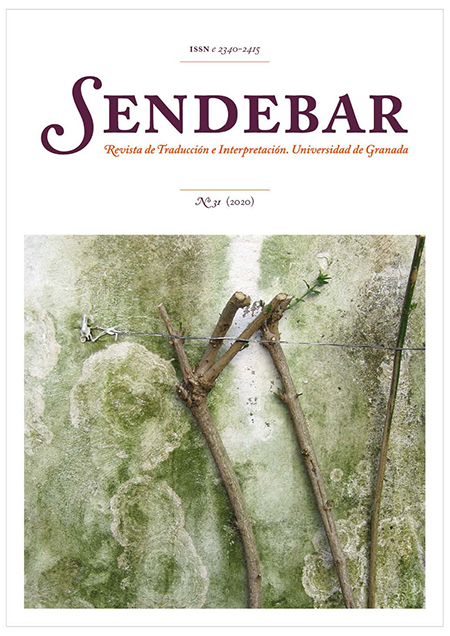Interpretación de la sátira en doblaje versus subtitulado: un estudio de caso de la traducción al árabe de la comedia estadounidense Los Simpson
DOI:
https://doi.org/10.30827/sendebar.v31i0.13604Palabras clave:
AVT, subtitulado, doblaje, humor, sátira, modelo de sátira de los SimpsonResumen
Este estudio investiga las estrategias de traducción utilizadas para convertir la sátira de la comedia animada estadounidense Los Simpson del inglés estadounidense al árabe estándar moderno (subtitulado) y al idioma vernáculo egipcio (doblaje). Además, intenta desvelar la contribución de la variedad lingüística y la modalidad de traducción en la interpretación de la sátira. El estudio se basa en el modelo estilístico de humor satírico de Simpson (2003) para comprender y analizar la sátira. Además, adopta la taxonomía de Mateo (1995) para destacar las estrategias utilizadas en el doblaje y subtitulado de la sátira. La aplicación de estos dos modelos ayuda a examinar los problemas planteados por la naturaleza de la sátira y los cambios en la configuración de la sátira cuando se traduce del inglés al árabe, así como la efectividad de estos cambios.
Los hallazgos del estudio muestran que la naturaleza sociocultural de la sátira plantea un serio desafío para los traductores. Además, se ha demostrado que la subtitulación tiende a utilizar la estrategia de traducción literal para representar una sátira en instancias que comparten el mismo trasfondo del texto original y excluye las basadas en aspectos socioculturales. Por el contrario, se observa que el doblaje tiende a utilizar la estrategia de efecto equivalente, que resultó ser suficiente a la hora de adaptar elementos socioculturales de la sátira. Por último, la variedad de idiomas y la modalidad de traducción parecen regir la eficacia de la traducción al árabe de la sátira.
Descargas
Citas
Abrams, Meyer H. (1993). A glossary of literary terms, (6th ed.). USA: Harcourt Barce College Publishers.
Ageli, Nuri. (2014). For better or for worse: The challenges of translating English humour into Arabic. Journal of Human Science. (23):414-426. Retrieved from
https://journal.uob.edu.bh/bitstream/handle/123456789/1229/JHS20140209.pdf?sequence=1
Al-Quinai, Jamal. (2005). Manipulation and censorship in translated texts. Paper presented at II AIETI. Actas del II Congreso Internacional de la Asociación Ibérica de Estudios de Traducción e Interpretación, Madrid, 9-11 February.
Altakhaineh, Abdel Rahman Mitib. (2017). Arabic compounds within the cross-linguistic compound taxonomy of Scalise and Bisetto (2009). Lingue e linguaggio. (16)1:101-118.
Applebee, Arthur. (1997). The language of literature: British literature. Evanston: McDougal Littell.
Attardo, Salvatore. (1994). Linguistic theories of humour. New York: Mouton de Gruyter.
Bremmer, Jan. & Roodenburg, Herman. (1997). Introduction: humour and history. A cultural history of humour from nntiquity to the present day. 1-10. Retrieved from https://www.rug.nl/research/portal/files/3215119/20146.pdf
Chaume, Frederic. (2012). Audiovisual translation: dubbing. Manchester: St Jerome.
Critchley, Simon. (2002). On humour (thinking in action). New York: Routledge.
Delabastita, Dirk. (1989). Translation and mass communication: Film and TV translation as evidence of cultural dynamic. Babel. (35)4:193-218.
Diaz-Cintas, Jorge. (2009). Audiovisual translation: An overview of its potential. Toronto: New Trends in Audiovisual Translation.
Diaz-Cintas, Jorge. & Remael, Aline. (2007). Audiovisual translation: subtitling. Manchester: St Jerome.
Dvořáková, Alena. (2012). Pleasure in translation: Translating Mill’s ‘Utilitarianism’ from English into Czech. ISFLL. (11)11:107.
Ferguson, Charles. (1959). Diglossia. Word. (15)2:325-340.
Florberg, & Lundborg. (2014). Understanding satire with The Simpsons. Sweden: Karlstad University thesis.
Gray, Jonathan (2009). Throwing out the welcome mat public figures as guests and victims in tv satire. In Satire TV: Politics and comedy in the post network era. Gray, Jonathan, Jones, Jeffery and Thompson, Ethan (eds.), 147-166. New York: NYU Press.
Gray, Jonathan, Jones, Jeffery & Thompson, Ethan. (2009). Satire TV: Politics and comedy in the post network era. New York: NYU Press.
Griffin, Dustin. (1994). Satire: A critical reintroduction. University of Kentucky Press.
Habermas, Jürgen. (1979). “What is universal pragmatics?”. Communication and the evolution of society. Boston: Beacon Press
Han, Qian. (2011). On untranslatability of English linguistic humour. Theory and Practice in Language Studies. (1)2:149-152. Retrieved from http://www.academypublication.com/issues/past/tpls/vol01/02/05.pdf
Kangas, Markus. (2018). Sounding out the bugle: Political satire in an “audio newspaper” format. Pro Gradu Thesis: University of Eastern Finland MA thesis
Kreuz, Roger & Roberts, Richard. (1993). On satire and parody: The importance of being ironic. Metaphor and Symbolic Activity. (8)2:97-109.
Perez-González Luis. (2014). Audiovisual translation: Theories, methods and issues. New York: Routledge.
Luyken, Georg-Michael. (1991). Overcoming language barriers in television: Dubbing and subtitling for the European audience. Manchester: European Institute for the Media.
Mateo, Marta. (1995). The translation of irony. Meta: Journal des traducteurs/Meta: Translators’ Journal. (40)1:171-178. Retrieved from https://www.erudit.org/en/journals/meta/1995-v40-n1-meta184/003595ar
Nemani, Faranak & Rasekh, Abbass Eslami. (2013). An investigation of the constraints in subtitling the conversations: On the role of cultural effects on variation. Journal of Educational and Social Research. (3)2:97-106.
O’Neal, Thomas. (1988). The translation of untranslatable jokes: Linguistic and cultural barriers in translating jokes. Albany: State University of New York.
Schmitz, John Robert. (2002). Humour as a pedagogical tool in foreign language and translation courses. Humor: International Journal of Humor Research. (15)1:89-114.
Simpson, Paul. (2003). On the discourse of satire: Towards a stylistic model of satirical humour. Amsterdam: John Benjamins Publishing.
Törnqvist, Egil. (1995). Fixed pictures, changing words. Subtitling and dubbing the film Babettes Gaestebud. TijdSchrift voor Skandinavistick. (16)1: 47-64.
Turner, Chris. (2005). How a cartoon masterpiece defined a generation. Cambridge, MA: Da Capo Press.
Wiersema, Nico. (2004). Globalisation and translation a discussion of the effect of globalisation on today’s translation. Translation Journal. (8)1:1-5.
Descargas
Publicado
Cómo citar
Número
Sección
Licencia
Terminos de Licencia Sendebar.

















